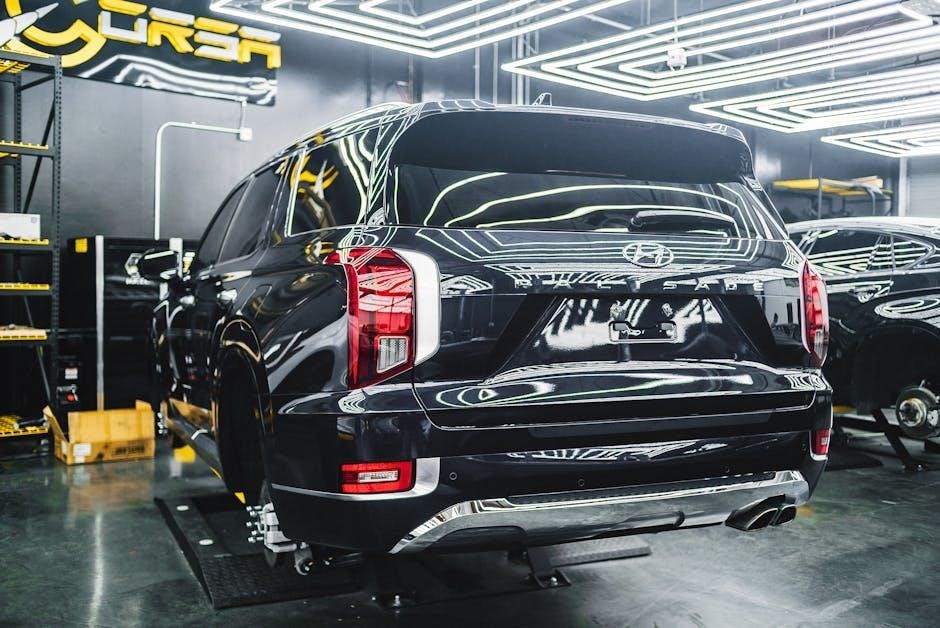Hyundai Sonata Service Schedule PDF: A Comprehensive Guide
This guide provides comprehensive information about maintaining your Hyundai Sonata, focusing on accessing and understanding the service schedule PDFs․ Regular maintenance, as outlined in the PDF, is crucial for optimal vehicle performance, longevity, and adhering to warranty requirements, ensuring your Sonata remains in top condition․
Understanding the Importance of Regular Maintenance
Regular maintenance is paramount for your Hyundai Sonata’s longevity, performance, and safety․ Adhering to the scheduled maintenance outlined in your owner’s manual, often available as a PDF, ensures your vehicle operates efficiently and avoids costly repairs down the road․ Routine checks and services, such as oil changes, tire rotations, and brake inspections, contribute significantly to maintaining optimal engine performance and fuel economy․

Furthermore, consistent maintenance helps preserve your Sonata’s resale value․ A well-documented service history demonstrates that the vehicle has been properly cared for, making it more attractive to potential buyers․ Neglecting routine maintenance can lead to decreased performance, increased fuel consumption, and potentially dangerous safety hazards․ Scheduled services allow technicians to identify and address minor issues before they escalate into major problems․

By following the recommended maintenance schedule, you can ensure your Hyundai Sonata remains reliable and safe for years to come․ Remember to consult your owner’s manual or a trusted mechanic for specific maintenance requirements tailored to your vehicle’s model year and driving conditions․ Maintaining your Sonata is an investment in its future․
Accessing Hyundai Sonata Service Schedule PDFs
Obtaining the Hyundai Sonata service schedule PDF is a crucial first step in ensuring your vehicle receives the necessary care․ The primary source for this document is typically the official Hyundai Motor America website․ Navigate to the “Owners” or “Service” section and locate the resource for your specific Sonata model year․ You’ll often find a digital version of the owner’s manual available for download, which includes the detailed maintenance schedule․

Alternatively, several reputable online databases specializing in car user manuals, such as CarManualsOnline․info, offer free access to Hyundai Sonata service schedule PDFs․ When searching, be sure to specify the correct model year to ensure the information aligns with your vehicle’s specifications․ These online resources allow you to view, print, or download the PDF for convenient access․
In some cases, your local Hyundai dealership may also provide a digital copy of the service schedule upon request․ Having the service schedule PDF readily available allows you to proactively plan and track your Sonata’s maintenance needs, ensuring adherence to recommended intervals and preserving its optimal performance and longevity․ Remember to verify the PDF’s authenticity and accuracy․

Key Maintenance Intervals: 7,500 Miles/6 Months
The Hyundai Sonata’s maintenance schedule is primarily structured around intervals of 7,500 miles or 6 months, whichever comes first․ This interval serves as the cornerstone for routine maintenance tasks designed to maintain your vehicle’s health and performance․ Adhering to this schedule is vital for preventing potential issues and ensuring long-term reliability․
These 7,500-mile/6-month intervals typically include essential services like oil changes, tire rotations, and comprehensive inspections of various vehicle components․ Regular oil changes ensure proper engine lubrication, preventing wear and tear, while tire rotations promote even tread wear, extending tire lifespan and improving handling․ Inspections cover critical areas such as brakes, fluids, lights, and other vital systems, allowing for early detection of potential problems․

It’s important to note that this is a general guideline, and specific maintenance requirements may vary depending on your driving habits and environmental conditions․ Consult your Hyundai Sonata service schedule PDF for detailed recommendations tailored to your specific model year and driving conditions․ Deviating from this schedule may affect the vehicle’s performance, fuel efficiency, and potentially void certain warranty provisions․ Therefore, consistency is key․
Essential Maintenance Tasks: Oil Changes and Tire Rotations
Oil changes and tire rotations stand out as cornerstones of Hyundai Sonata maintenance, crucial for preserving engine health and ensuring optimal tire performance․ Regularly scheduled oil changes are paramount; they replace degraded oil with fresh lubricant, preventing engine wear and maintaining efficient operation․ Clean oil ensures proper lubrication of engine components, dissipating heat and removing contaminants, all vital for engine longevity․

Tire rotations are equally important, promoting even tread wear across all four tires․ By rotating tires according to the recommended pattern, you prevent uneven wear patterns that can lead to premature tire replacement, compromised handling, and reduced fuel efficiency․ Regular rotations ensure that each tire experiences similar stress, maximizing their lifespan and maintaining consistent grip on the road․
These two tasks, oil changes and tire rotations, are typically performed together during the 7,500-mile/6-month service intervals․ Consulting your Hyundai Sonata service schedule PDF will provide specific recommendations for the type of oil to use and the recommended tire rotation pattern․ Neglecting these essential maintenance tasks can lead to significant issues, including engine damage and reduced tire lifespan, ultimately costing more in the long run․ Prioritizing these services ensures your Sonata runs smoothly and safely․
Inspections: Brakes, Fluids, and Lights
Comprehensive inspections of your Hyundai Sonata’s brakes, fluids, and lights are vital components of preventative maintenance, ensuring safety and optimal vehicle performance․ Brake inspections involve assessing the condition of brake pads, rotors, calipers, and brake lines․ Checking brake pad thickness is crucial to ensure sufficient stopping power, while examining rotors for wear and damage prevents vibrations and noise during braking․ Caliper functionality is also verified to ensure even brake pad wear, and brake lines are inspected for leaks or damage․
Fluid inspections encompass checking levels and conditions of essential fluids, including brake fluid, power steering fluid, transmission fluid, and windshield washer fluid․ Maintaining proper fluid levels ensures optimal system performance, while assessing fluid condition can reveal potential issues like contamination or leaks․ Addressing fluid-related problems promptly prevents costly repairs and maintains system reliability․
Finally, a thorough inspection of all exterior lights, including headlights, brake lights, turn signals, and hazard warning flashers, is essential for visibility and safety․ Ensuring all lights function correctly enhances visibility for both the driver and other motorists, reducing the risk of accidents․ Replacing burned-out bulbs promptly is crucial for maintaining optimal visibility and adhering to traffic laws․ These inspections, performed regularly, safeguard your Sonata’s reliability and your on-road safety․

Timing Belt and Spark Plug Replacement Guidelines
Adhering to recommended replacement guidelines for the timing belt and spark plugs in your Hyundai Sonata is crucial for maintaining engine health and preventing costly repairs․ The timing belt, responsible for synchronizing the crankshaft and camshaft, should be replaced at the interval specified in your Sonata’s service schedule․ Failure to do so can result in belt failure, potentially causing severe engine damage, including bent valves and damaged pistons․
Consulting your owner’s manual or a trusted mechanic is essential to determine the correct replacement interval for your specific Sonata model and engine type․ Similarly, spark plugs, responsible for igniting the air-fuel mixture in the engine cylinders, should be replaced at the recommended interval․ Worn or fouled spark plugs can lead to reduced engine performance, decreased fuel efficiency, and increased emissions․

Replacing spark plugs involves removing the old plugs and installing new ones, ensuring the correct gap and torque specifications are followed․ Using the recommended type of spark plug for your Sonata is crucial for optimal engine performance․ By following the timing belt and spark plug replacement guidelines outlined in your service schedule, you can ensure your Sonata’s engine operates smoothly and efficiently, preventing potential breakdowns and extending its lifespan․ Neglecting these crucial maintenance tasks can result in significant engine damage and costly repairs․
Checking for Fluid Leaks and Coolant Levels
Regularly checking for fluid leaks and monitoring coolant levels are essential maintenance practices for your Hyundai Sonata, helping to prevent potential engine damage and ensure optimal performance․ Inspecting for fluid leaks involves visually examining the areas under your car for any signs of dripping or pooling fluids․ Common leak locations include the engine, transmission, brake lines, and power steering system․ Identifying the type of fluid leaking can help pinpoint the source of the problem․ For example, oil leaks are typically dark brown or black, while coolant leaks are often green or orange․
Coolant level is crucial for regulating engine temperature and preventing overheating․ Check the coolant level in the engine coolant reservoir regularly, ensuring it is within the “MIN” and “MAX” markings․ If the coolant level is consistently low, it may indicate a leak in the cooling system․ Low coolant levels can lead to engine overheating, potentially causing severe damage․ If you notice any fluid leaks or consistently low coolant levels, it is recommended to consult a qualified mechanic for diagnosis and repair․
Addressing fluid leaks and maintaining proper coolant levels promptly can prevent costly repairs and extend the life of your Hyundai Sonata’s engine․ Water dripping from the air conditioning system during or after use is normal․
Warranty Considerations and Emission Services
Maintaining your Hyundai Sonata’s warranty requires adherence to the manufacturer’s recommended service schedule, detailed within the service schedule PDF․ Neglecting scheduled maintenance can potentially void warranty coverage for related components, making it crucial to follow the prescribed intervals․ Keep detailed records of all services performed, including dates, mileage, and descriptions of the work completed․ These records serve as proof of maintenance and are essential for warranty claims․
Emission services are another critical aspect of vehicle maintenance, ensuring your Sonata meets environmental regulations and operates efficiently․ These services typically involve inspections and maintenance of components related to emission control, such as the catalytic converter, oxygen sensors, and fuel system․ Regular emission services not only help protect the environment but also contribute to optimal engine performance and fuel economy․ Keep receipts for all vehicle emission services to protect your warranty․

Hyundai recommends specific emission services at certain mileage intervals․ Consult your service schedule PDF or your authorized Hyundai dealer for specific recommendations․ Failure to perform these services can result in failed emission tests, fines, and potential damage to your vehicle’s emission control system․ By staying on top of both scheduled maintenance and emission services, you can protect your warranty, ensure your Sonata operates cleanly, and maintain its long-term value․
Model-Specific Service Schedules (e․g․, 2015, 2020, DN8)
Hyundai Sonata service schedules vary depending on the model year and specific generation․ For example, a 2015 Sonata will have a different maintenance schedule compared to a 2020 model or a DN8 (2019+) generation․ These differences arise due to variations in engine design, technology, and overall vehicle architecture․ Always consult the correct service schedule PDF for your specific Sonata model to ensure accurate maintenance․
To find the appropriate PDF, start by identifying your Sonata’s model year and generation․ This information can typically be found in your owner’s manual or on a sticker located on the driver’s side doorjamb․ Once you have this information, you can search online for “Hyundai Sonata [Year] service schedule PDF” or “Hyundai Sonata DN8 service schedule PDF․” Reputable sources include the Hyundai Motor America website and car manuals online databases․
The model-specific service schedule PDF will outline the recommended maintenance tasks and intervals tailored to your vehicle’s unique characteristics․ This includes details such as the type of oil to use, the frequency of oil changes, and the specific components that require inspection or replacement at certain mileage milestones․ Adhering to the model-specific schedule ensures optimal performance and longevity for your Sonata, taking into account the nuances of its design and engineering․





